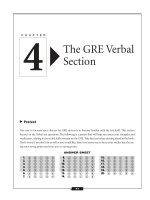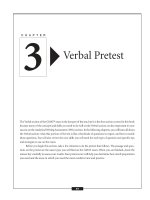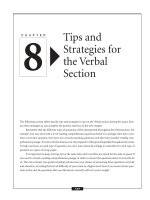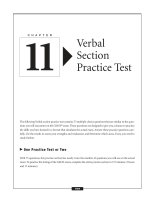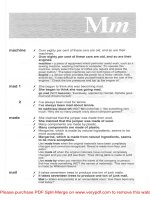Gre verbal section 6 pdf
Bạn đang xem bản rút gọn của tài liệu. Xem và tải ngay bản đầy đủ của tài liệu tại đây (61.71 KB, 6 trang )
something unusual, different from the norm. But the way in which it is unusual differs significantly between
sentences. A revolutionary idea is unusual in that it is new and unlike ideas that came before; it changes things
dramatically. A radical idea, however, is unusual because it is extreme. From the word choice, we can infer that
the writer of sentence a feels very positive about Higgins’s proposal, while the writer of sentence b may feel
concerned about the extreme nature of Higgins’s plan. The writer doesn’t need to spell out his or her feel-
ings because the word choice makes his or her position clear.
DENOTATION AND
CONNOTATION
Even words that seem to mean the same thing have subtly different meanings and sometimes not-so-subtle
effects. For example, look at the words dangerous and perilous. If you say, “The situation is dangerous,” that
means one thing. If you say,“The situation is perilous,”that means something slightly different. That’s because
dangerous has a different connotation than perilous. Connotation is a word’s suggested or implied meaning;
it’s what the word makes you think or feel. Dangerous and perilous have nearly the same denotation or dic-
tionary definition—in fact, each word is used in the definition of the other. But perilous suggests more threat
of harm than dangerous suggests. Peril has a more ominous ring to it than danger has and suggests a more
life-threatening situation. Perilous and dangerous, then, have different connotations, and the word you choose
to describe the situation can tell others a lot.
EUPHEMISMS AND DYSPHEMISMS
Another way writers use word choice to reveal their feelings is through the use of euphemisms and dysphemisms.
A euphemism is a neutral or positive word used in place of something negative. A common example is to sub-
stitute the phrase passed on or departed for died.A dysphemism, on the other hand, uses a negative word or phrase
(instead of something neutral or positive), such as saying croaked or kicked the bucket for died. To cite a business
example,“I’ve been let go” is a euphemism and “I’ve been axed” is a dysphemism for “I’ve been fired.”
Seven Strategies for Reading Comprehension Questions
1. Read actively! As you read, ask yourself what each paragraph is about. Make notes about the passage;
react to it on your scratch paper. Be an engaged reader. Try to become interested for a few minutes in
the passage’s subject.
2. If you have an especially good short-term memory, you may want to look at the questions before you
read the passage. Jot down the words and phrases the questions ask about, then look for those words
and phrases in the passage. When you find them, you can either go ahead and answer the question
right then or note the area to come back to later.
3. If you don’t understand what a question is asking, rephrase the question using your own words. GRE
questions are written in a very precise, formal style in order to eliminate any ambiguity. Unfortunately,
nobody talks that way, so the questions can be confusing at first glance. Once you have noted the key
words and phrases, rewrite the question in a way that makes sense to you. Don’t be afraid to add new
words to the question; just be sure the words express the same ideas as the question, and don’t change
the meaning in any way.
– THE GRE VERBAL SECTION–
115
4. Once you understand a question, try to answer it in your own words before looking at your answer
choices. Distracter answers often take one of several forms:
■
They are close to the correct answer, but are wrong in some detail.
■
They are true, but do not answer the question.
■
They use language found in the text, but are not the correct answer.
5. As with all the multiple-choice questions on the GRE, elimination is an important strategy for the
reading comprehension questions. Even if you don’t know the answer to a particular question right
away, you often will be able to eliminate one to three answer choices without even referring back to the
passage. Then you know that one of the remaining answers is the correct one and you can spend your
time more productively looking in the passage for information to back up your choice.
6. Expect to refer back to the passage on virtually every question. If you know the answer to a question
without referring back, that’s fine, although it might be a good idea to check the passage anyway, just
to make sure you haven’t fallen for a distracter answer.
7. Remember to read between the lines! With the sentence completion questions, you may remember
that you must be extremely literal and never read anything into them or bring in any ideas that are not
clearly expressed within the sentence itself. This is not true with reading comprehension questions. In
fact, you will be asked to interpret almost every passage, to draw conclusions from the text, and to
extend the author’s point of view to evaluate a statement that is not even in the passage.
Tips and Strategies for the Official Test
Now you have tried your hand at some practice questions. You had read strategies for each of the four kinds
of Verbal questions and started to absorb them. You have already learned some new vocabulary.
Here are the strategies you have learned for each type of question. As you read through the list, make
sure you understand each one. If you encounter a strategy you don’t understand, go back to the lesson for
that type of question and read about the strategy one more time.
Analogy Strategies
■
Find the relationship between the stem (initial) pair of words.
■
Remember, words represent concrete or abstract things, which have relationships.
■
Find the answer pair with the same kind of relationship (analogous).
■
Be flexible about the meanings of words.
■
Check for a part-to-whole relationship.
■
Check for a relationship of contrast/antonyms/opposites.
■
Check for a type of relationship.
■
Check for a degree of relationship.
■
Check for a use or purpose relationship.
■
Check for a tool to worker relationship.
– THE GRE VERBAL SECTION–
116
■
To reveal relationship, make a sentence using both stem words.
■
Try reversing stem words if necessary to find their relationship.
■
If more than one answer is still a possibility, make your sentence more specific.
■
The more difficult the analogy is, the more specific the sentence must be.
■
One way to make more specific sentences is to use active verbs (not state-of-being verbs, such as is).
■
Check the answer pairs for a relationship parallel to the stem word’s relationship.
■
Remember, many words have two or more meanings.
■
Often, different meanings of the same word are different parts of speech.
■
If a stem word is not a difficult word, its appropriate meaning is likely to be a less-common usage of
the word.
■
Make sure you are focusing on relationships, not on meanings.
■
Don’t choose distracter words with similar meanings to the stem word’s meanings.
■
Eliminate wrong answers as a way to find the right answer.
■
Think about the functions of the stem word and the answer choices.
■
Form visual images of the stem word and/or answer choices.
■
Stay flexible. If one strategy is not working, try another.
Antonym Strategies
■
The logical relationship embedded in each antonym question is one of opposition.
■
Train yourself so that alarms will go off in your head when you see a synonym as one of your
answer choices, and eliminate it.
■
If the stem word has no diametrically opposed antonym, choose the word or phrase that is most
nearly opposite the stem word.
■
Look for the concept among the answer choices that most nearly opposes the concept of the
stem word.
■
Eliminate any answer choices that don’t have opposites.
■
If you can’t decide between two seemingly correct answers, try to more precisely define the
stem word.
■
Try to remember the contexts in which you have seen a stem word.
■
Try writing a sentence using the word.
■
Substitute the possible answers into your sentence. The answer word or phrase that does the best
job of changing the meaning of the sentence into its direct opposite is correct.
■
Use root words, prefixes, and suffixes to help determine a word’s meaning.
■
Remember, an unfamiliar word may be related to a word you know in another language.
■
Be flexible—many words have more than one meaning.
■
Use parts of speech to help you remember a word’s various meanings.
■
Improve your vocabulary! Make it fun by playing vocabulary games.
■
Use new vocabulary in conversation or writing to help you remember.
– THE GRE VERBAL SECTION–
117
Sentence Completion Question Strategies
■
Sentence completion questions test your understanding of logical relationships.
■
The most important key to the meaning of a sentence is its structure.
■
The easiest way to determine sentence structure is to use punctuation to guide you.
■
First, decipher the thought in the sentence unit without blanks, then fill in the blank(s) with a word
or phrase that expresses a logically related thought.
■
Sometimes, you have to complete one portion of a two-blank sentence before you can work on the
logical relationship of another unit.
■
Signal words and phrases help you identify the logical relationship between the complete unit(s) of
the sentence and the incomplete unit(s).
■
There are three types of logical relationships common to sentence completion questions: contrast,
comparison, and cause and effect.
■
Words that signal a logical relationship of contrast are words such as though, although, however,
despite, but, and yet.
■
Phrases that signal contrast are phrases such as on the other hand or on the contrary.
■
There are two kinds of comparison relationships: comparison by similarity and comparison by
restatement.
■
Words that signal comparison are words such as likewise, similarly, and and itself. Phrases that sig-
nal comparisons are just as, as _______ as, for example, as shown, and as illustrated by.
■
Words and phrases that signal restatement are namely, in other words, in fact, and that is.
■
In restatement sentences, the idea expressed in the complete unit of the sentence is similar to or the
same as the idea that needs to be expressed in the incomplete unit.
■
A third kind of logical relationship often expressed in sentence completion questions is cause and
effect, in which one thing is a result of something else.
■
Words such as thus, therefore, consequently, and because and phrases such as due to, as a result, and
leads to signal cause and effect.
■
Start small. Don’t tackle the whole sentence at once.
■
If the guiding commas and semicolons are not there, find a verb and gradually incorporate the
words around it as you decipher its meaning.
■
Find islands of meaning in a sentence and gradually enlarge each one.
■
Use the surrounding context to help you guess the meaning or at least the part of speech of an
unfamiliar word.
■
Substitute words or sounds of your choosing in place of unknown words as you read.
■
Don’t look at the answers to see what word(s) might go in the blank(s); decide first what the answer
needs to express.
■
It’s fine to use a phrase instead of a word, as long as you are clearly expressing the meaning you
think the correct answer choice will express.
■
Stick to what is expressed in the sentence. Don’t incorporate other ideas.
– THE GRE VERBAL SECTION–
118
■
If you see an answer choice that seems to match your idea, see if it fits into the sentence without
introducing any new idea.
■
Look at all the answer choices before making your final selection.
■
Use the process of elimination.
■
Never eliminate an answer choice just because you don’t recognize the word.
Reading Comprehension Question Strategies
■
The reading comprehension questions test your ability to understand what you read.
■
From each passage, you must be able to extract information, both expressed and implied.
■
Phrases such as the passage implies that and the author suggests that require you to use the
given information to form your own conclusions.
■
First, skim the passage for its subject matter.
■
Jot down important or expressive words and phrases as you see them, and note line numbers in
which they are found.
■
Adjectives that set a mood will help establish the author’s tone.
■
As you finish each paragraph, determine its main idea. Jot it down.
■
The main ideas of each paragraph can be quickly tied into a coherent whole that will express the
theme or point of the passage.
■
Make note of details that support the author’s main point(s).
■
Don’t write more than you need, but be sure you can make sense of what you write.
■
Include line numbers along with your notes, so you will know where to look in the passage.
■
Try to become interested for a few minutes in the subject of each passage.
■
Try looking at the questions before you read the passage or before you reread it.
■
Jot down the words and phrases the questions ask about, then look for those words and phrases in
the passage.
■
If you don’t understand what a question is asking, rephrase the question using your own words.
■
Once you understand a question, try to answer in your own words before looking at the answer
choices.
■
Distracter answer choices may be close to the correct answer, but wrong in some detail.
■
Distracter answer choices may be true statements, but not the correct answer to the question.
■
Distracter answers may use language found in the text, but may still be the wrong answer.
■
Elimination is an important strategy for reading comprehension questions.
■
Expect to refer back to the passage on virtually every question, even if just to make sure you haven’t
fallen for a distracter answer.
■
Read between the lines!
■
Seek out your own difficult passages and practice writing questions about them.
■
Practice these techniques before the exam.
■
As you practice, try variations on the method to see what works for you.
– THE GRE VERBAL SECTION–
119


